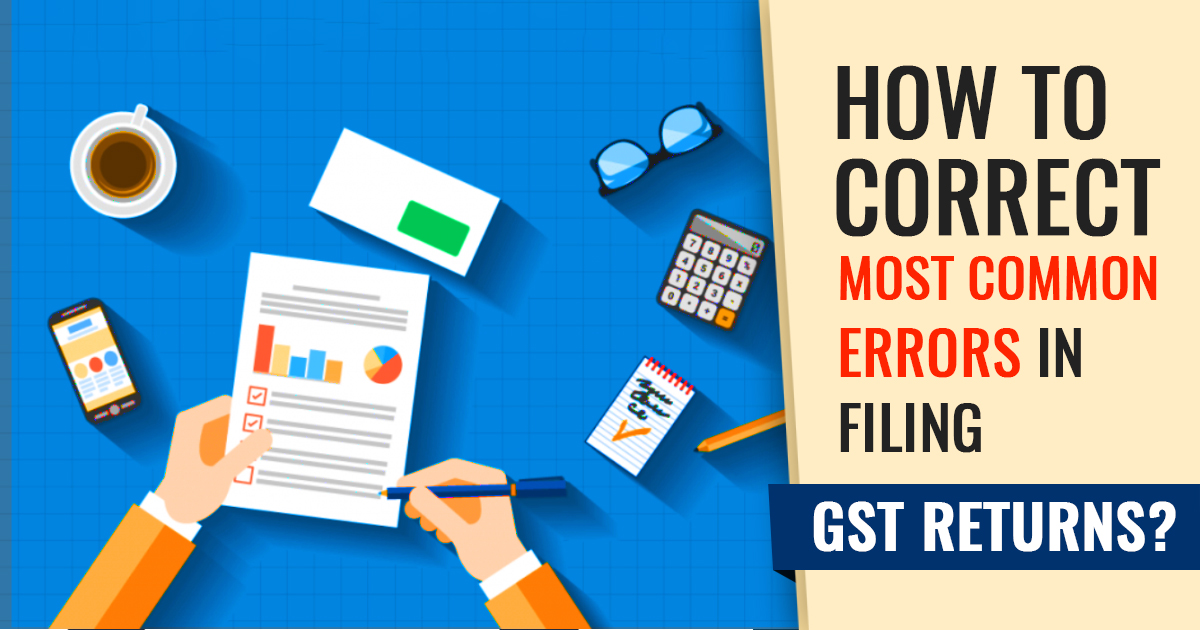Over the past few days, businesses and chartered accountants have been busy in filing GST returns on the online GST portal. However, the GST return filing experience has not been very good for most of these users, due to less understanding of GST norms. Server overload and similar errors were faced by many users when filing their GST returns online. But there are some specific GST return errors/mistakes that were made by users when filing their returns online, mainly because of the lack of GST knowledge.
There are two major kinds of errors faced by people on the GST portal – software (platforms) errors and human errors (made by people in their returns). In this article, we will discuss the errors caused by human mistakes with possible solutions.
Contents
How to Correct Errors/Mistakes in GST Returns
There are some mistakes, which if not corrected on time, can cause much deficiency in the entire tax structure of your business. Read on about the common mistakes people are making in their GST returns and how to resolve them.
1: Making tax payment under wrong GST head
You cannot pay IGST when you are supposed to pay CGST, and vice-versa. Many people are making this mistake as they are unable to differentiate between the three GST heads – IGST, SGST and CGST.
Since many businesses (who are not fully aware of GST) still do not know which transactions come under which head of GST, they are paying taxes under wrong heads. As per the rules, all the interstate transactions are liable for IGST, while all the intra-state transactions are liable to pay CGST + SGST tax.
For example, a business that was supposed to pay 4,000 as IGST, 3,000 as CGST, and 3,000 as SGST has instead paid 7,000 as IGST. So, the equation goes wrong. The thing is that even if you have paid your total tax liability for a particular tax period, your tax liability is still pending until you pay the right amount in the right GST head.
Solution
As per the official GST provisions, the excess tax paid in a particular GST head (such as IGST) cannot be utilized to compensate the tax liability of any other head (like SGST/CGST). It can only be used to make future adjustments or can be reclaimed back. And the taxpayer will still have to pay the pending tax liability for particular heads.
One negative impact of this mistake will be the short term loss of working capital due to the excess tax paid.
Download GST Return Rules in PDF Format
2: Treating zero-rated (export) supplies as nil-rated and vice-versa
All the exports under GST will be treated as zero-rated supplies. That doesn’t mean that the tax rate on such items will be zero percent. It means that the tax paid on exports (and imports) will be refunded back (ITC) in full.
Nil-rated supplies are the ones which are taxed at 0% or nil rate, and ITC is not applicable to them.
Now, since many people are not aware of this difference, they are listing their exports under nil-rated supplies. When this happens, the taxpayers will not be able to claim ITC on such supplies and there will be no refund of the tax paid, which is obviously going to be a major concern for exporters.
Solution
The only obvious solution to this problem is to be careful while filing your GST returns and provide the information of your exports in the right column. All exports are zero-rated, not nil rated or exempted from GST.
3: Paying reverse charge wrongly
Under the reverse charge mechanism, the recipient is required to pay the tax instead of the supplier. Some people are making mistakes in this part as well.
As per the rules, in some special cases, such as for supplies made by an unregistered person to a registered person, the GST will be paid by the recipient. However, many suppliers are also by mistake paying GST on such RCM transactions.
For example, a supply was made by A worth Rs. 50,000 at 18% GST to recipient B. The supply is under RCM and so B is required to pay the tax, not A. But A doesn’t know this and pays tax amount as well.
Solution
There is no mechanism for compensating the additional tax paid under RCM. The recipient will still be required to pay GST even if the supplier has already paid it. However, the supplier can claim the excess tax paid in the form of ITC.
4: No GST returns for zero sales
According to the GST provisions, it is mandatory for all the registered taxpayers to file their regular GST returns even if there was no sale in a particular tax period. There will be a fine on late filing or no filing of GST returns for any month/quarter.
Many businesses still think that they are not supposed to file a return if there was no sale in a tax period. That is not true. If there was no sales or no turnover in a tax month, you are still required to file a nil return. A penalty will be levied from such taxpayers who forget or avoid filing nil returns in such cases.
You can file your GST Returns in easy way with Gen GST Software.







GST CMP 08 One Person Filling Process Error in Payament Amount Should Not Exceed The Outstanding Libility What Is Solution
Please read more here about GST CMP 08